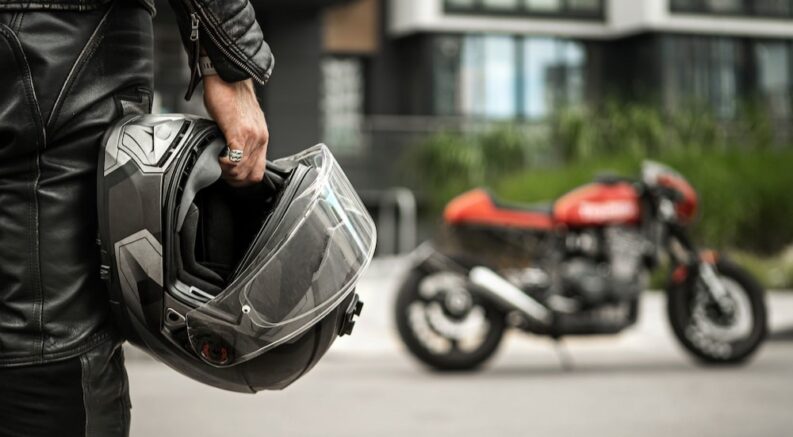If you’re getting ready to buy a motorcycle, then you need a helmet. Even if you live in one of the states that do not have a helmet law, riding with a helmet is a much more comfortable experience and increases your chances of surviving a crash by roughly 40%. However, there are a ton of options out there, and it can be a little overwhelming trying to find the right one for your needs. Buying the wrong helmet can make riding unpleasant and may fail to provide the full safety benefits you seek. The good news is that paying attention to a handful of key points when shopping will quickly put you on the right track, and high-quality helmets with tons of features are available for under $200.
Style
Safety gear and style may not commonly go together, but a motorcycle helmet can be as much of a fashion statement as it is protective equipment. Not only does having a cool helmet make you want to wear it whenever you ride, but different styles of helmets are commonly used for different types of riding and provide different benefits. Of course, not every style of helmet is worth considering. There are some that you should discard out of hand, like the half-helmets often favored by Harley riders. Open face helmets do provide some protection in a crash, but you definitely want something that shields your face from injury, dust, and bugs. You also want to avoid any novelty helmets with protruding attachments that could catch on something if you hit your head.
Full-Face Helmets
Full-face helmets are traditional motorcycle helmets, incorporating wrap-around jaw protection and a sliding visor. They are the best place to start if you are buying your first helmet, as they can be used for virtually any type of riding, although they are typically most favored by sport bike and naked bike riders. Thanks to their ubiquitous nature and relatively simple design, they also typically provide the best protection for your money.
Modular Helmets
On long trips, a traditional full face helmet can become a hassle since you have to remove the helmet to touch your face, put on or remove glasses, take a drink of water, or communicate clearly. This is where modular helmets come into play. The entire front section of these helmets can swing out of the way, providing you with the protection of a full face helmet and the convenience of an open face helmet. The downside is that these helmets are typically heavier and more expensive, and may not have the same safety ratings. Still, they can be a great choice if you have an adventure bike or a touring bike and want something comfortable on long rides.
Off-Road Helmets
These typically do not include a visor and are meant to be paired with goggles, but still have a section that wraps around your jaw to protect your face. Off-road helmets also usually incorporate a brim and have greater airflow than full face helmets. These are great points if you are riding a dual sport or taking an ADV bike off-road, where you will be spending most of your time at lower speeds. However, these elements can be very loud and cause wind buffeting at higher speeds.

Safety Ratings
Once you know what style of helmet you want, the next detail to look for is the safety rating. If a helmet does not have a DOT, Snell, or ECE certification, then you should not trust it to protect you. In general, you will probably be fine with a helmet approved by any of these three organizations, but the three ratings are not all created equal. Certain activities, like attending a track day, may demand certain certifications.
DOT
DOT approval is the baseline for all motorcycle helmets. This rating states that the helmet meets the Federal Motor Vehicle Safety Standard No. 218 laid out by the United States Department of Transportation. This regulation dates back to 1973, although it was most recently updated in 2013. To get a DOT rating, a helmet must pass certain tests for energy absorption, penetration resistance, and chin strap integrity. However, this rating is self-certified by the helmet manufacturer and only formally tested by the DOT if there is suspicion that it doesn’t meet standards.
Snell
This rating is administered by the Snell Foundation, an independent non-profit created in 1957 after the death of race car driver William Snell to improve the quality of racing helmets. A Snell rating is considered a step up from a DOT rating and is often required to participate in motorsports events. Not only does the Snell Foundation lay out much stricter requirements than the DOT and update them on a more regular schedule (typically every five years), but it also tests every helmet at its California laboratory before giving it a Snell rating. The most recent Snell standards are M2025D and M2025R. You can find the rating on a special holographic sticker inside the helmet.
ECE
The third standard is ECE, which is administered by the Economic Commission for Europe. This is the legal minimum for a helmet to be sold in Europe, and can be found on many helmets sold in America by European manufacturers. Like Snell, ECE requires considerably more rigorous testing than DOT and is updated regularly, making for what is generally considered a safer helmet. However, Snell and ECE have different philosophies, with Snell focusing on resisting impact and penetration, while ECE emphasizes reducing rotational forces. There is considerable debate about which is more important, but you can rest assured that both ratings produce a very high-quality helmet. The most recent ECE rating is 22.06, which was released in 2023.
Sizing
After choosing a helmet that meets your acceptable style and safety standards, it is crucial that you get one that fits properly. If possible, find a physical store with a knowledgeable staff that will let you try on different helmets and check their fit. If you don’t have such a store in your area, make sure to carefully read the manufacturer size charts and measure your head properly. The ideal helmet fitment will be snug and won’t allow movement independently of your head. A loose helmet will not protect you properly in a crash, so don’t be afraid to send a helmet back if it doesn’t fit correctly.
Most helmet manufacturers only produce two or three outer shell sizes, and then use different interior foam to create a larger number of available sizes. This means that as long as the shell size is right, you might be able to get different foam to make it fit correctly. Some of the top-tier helmets even offer customizable foam to get the perfect fitment.
Also pay attention to the helmet shape. Human heads vary in shape as well as size, and helmet manufacturers will usually state if a helmet is intended for Round Oval, Intermediate Oval, or Long Oval heads. Intermediate Oval is the most common and fits most riders, but if you’re having difficulty finding a helmet that feels comfortable, this is something that you will want to pay attention to. Even within these categories, different manufacturers sometimes design their helmets in slightly different ways. That’s why some riders say they have a Shoei head or an Arai head, since one brand may fit their head better than others.

Features
The final detail you will want to look at is what features the helmet offers. These days, there are many high-quality options for every style, rating, and size, so choosing a helmet largely comes down to price point and features. Obviously, the most affordable helmets will have the fewest features, and that will usually be fine for your first helmet. However, once you start riding, you may find that you want some specific features for comfort or convenience reasons.
Weight is one of the most important features to consider. While it is less tangible than other features, a lightweight helmet can make riding more enjoyable. Visor upgrades are also important. You will probably want a helmet that offers tinted visors to help you see in bright sunlight and is Pinlock compatible. Pinlock is an anti-fog device that uses a small plastic shield attached to the inside of the visor and is well worth the money. Some helmets include a built-in sun visor that slides up and down using a lever on the outside of the helmet. This can replace sunglasses and is particularly useful when riding in and out of forests or tunnels, where lighting conditions can change rapidly.
If you want to ride with friends or just listen to music, then you will likely want to add a Cardo or Sena communication unit. These connect to your phone and other nearby units, allowing you to talk with friends during a group ride. Some helmet manufacturers offer integrated communications options, which may be more streamlined, but make sure they are compatible with what your friends are using.
A Good Helmet Is Worth the Investment
There is no arguing with the benefits of a good motorcycle helmet, and it is easier than ever to find a quality option that fits your needs perfectly and looks good while doing it. Although it is certainly possible to spend $1000 or more on a high-end carbon fiber helmet packed with features from a brand like Shoei or Arai, you can get a Snell or ECE rated full face helmet from brands like HJC, Scorpion, or Bell for well under $200. At a price like that, this is one investment that is a no-brainer for any rider.

